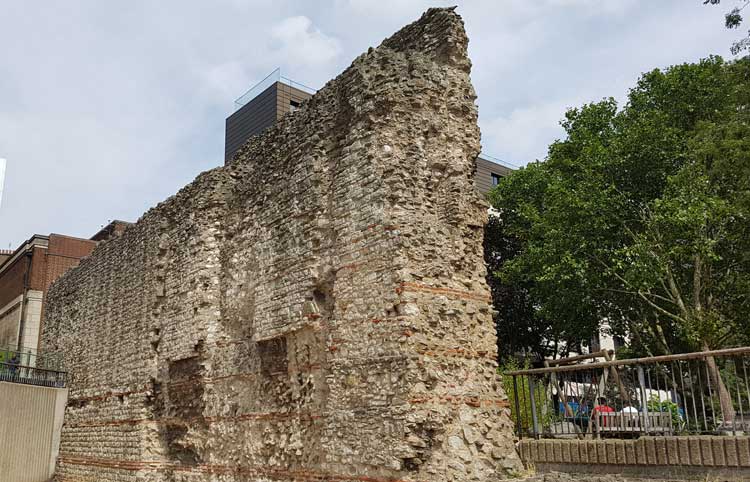
One of the most impressive sections of London's Roman City wall can be found just outside the entrance to Tower Hill Underground Station.
It stands 35 feet (10.6 metres) high, albeit only the first 14 feet (4.4 metres) is, in fact, Roman, the upper 21 feet (6.4 metres) consisting of medieval additions plonked on top of the Roman remains at various stages between the 12th and 17th centuries.
You have to give it to the Romans, they did an awful lot for the City of London.
Such as? I hear you ask.
Well, let's begin with the beginning.
As far as can be ascertained, it was the Roman's who founded what is now the City of London - albeit, they didn't actually call it London, preferring, instead, the more exotic sounding Londinium.
Anything else?
Well, actually, yes.
In around the year AD200, Londinium had become such an important city that they decided to surround it with a protective wall.
To this end, they shipped more than one million blocks of ragstone, quarried near Maidstone, in Kent - amounting to some 1750 boatloads - up the Thames, and set about building a massive wall around their city.
This wall encircled Londinium for one square mile (almost 3 Kilometers), and for the next 2,000 years it shaped the layout of the City of London - and, to a large extent, it still does.
It was a truly impressive accomplishment, and was easily one of the largest building projects ever undertaken in Roman Britain.
The finished article was 20 feet (96 metres) in height, around 8 feet (2.5 metres) thick, there were 22 towers spaced out at intervals around its circumference, and the outer wall had a ditch, or a fossa, in front of it that was almost 7 feet deep and 16 feet wide.
The impact on anyone approaching the wall with evil intent can only be guessed at; for my part I would have simply taken one look at the mighty bulk looming menacingly before me, decided that getting through it or over it just wasn't worth the effort, turned heel and devoted my attention to pillaging and sacking Tower Hamlets, which, given it wouldn't exist for almost a thousand years, would, I'm sure you'll agree, have been an impressive achievement!
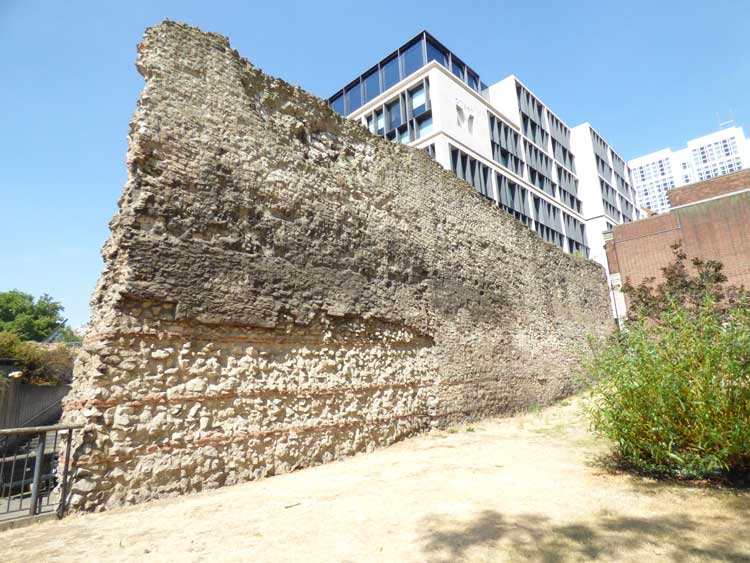
The Roman's departed these shores in the year AD410 and, over the next 1600 years, the wall enjoyed mixed fortunes.
During the Saxon period it fell into decay. The Normans, recognising its strength and importance, rebuilt and heightened large sections of it, adding numerous gates to allow ingress and egress through its mighty bulk, and this pattern of heightening and repairing continued, unabated, between the 12th and 17th centuries, until, from the late 17th century onwards, London began to expand beyond the corset of the old wall, and a period of relative peace and tranquility meant that London no longer needed to be defended from nefarious sorts lurking without the City walls.
Bit by bit, the wall began to disappear and, by the 19th century, very little of it remained; or, to be more precise, very little of it remained visible to the casual stroller going about their everyday business.
But, large fragments of the wall were, in fact, still there, sleeping like a colossus, awaiting the day when it could awaken from its slumbers, and, once more, rear up and repel any troublesome types that might be heading London's way on the 8.15 train from Colchester, Chelmsford, or any other hostile tracts of East Anglia, providing the line hadn't been closed for planned engineering work.
You see, generations of Londoners - or at least generations of builders and speculators - soon discovered that those awfully nice Legionnaires had done something that could save them a great deal of time and expense. They had left behind sturdy walls made up of over a million solid blocks of stone that could be utilised in the construction of all manner of building projects, from castles, to churches, to halls, to houses to warehouses.
And thus, what, at the time, may have seemed like cultural vandalism, proved to be the savior of large chunks of the Roman wall.
For with buildings being built on to them, these, sometimes quite large, sections of impressive masonry managed to survive, until, from the mid-19th century onwards, Londoners became more appreciative of, and, therefore, more protective of, the relics of days gone by.
The magnificent segment of the Roman wall that looms up directly outside the entrance to Tower Hill Underground Station is, to put it mildly, awe-inspiring.
And yet, it gets relatively little attention paid to it by the thousands of people who swarm out of Tower Hill Underground Station and head across, or under, the main road to reach the Tower of London.
They simply walk straight past this historic relic, not paying it a second glance, the majority of them not even realising that they are alongside an important survivor from Roman London.
However, it is important to note that this piece of wall, as impressive as it is, is not all Roman.
In fact, it is only the lower section that dates from the age of the Romans, the upper section being part of the aforementioned medieval heightening of the walls.
The best way to explain what is Roman and what is not, is to take a close look at it.
So, here it is again, in close-up.
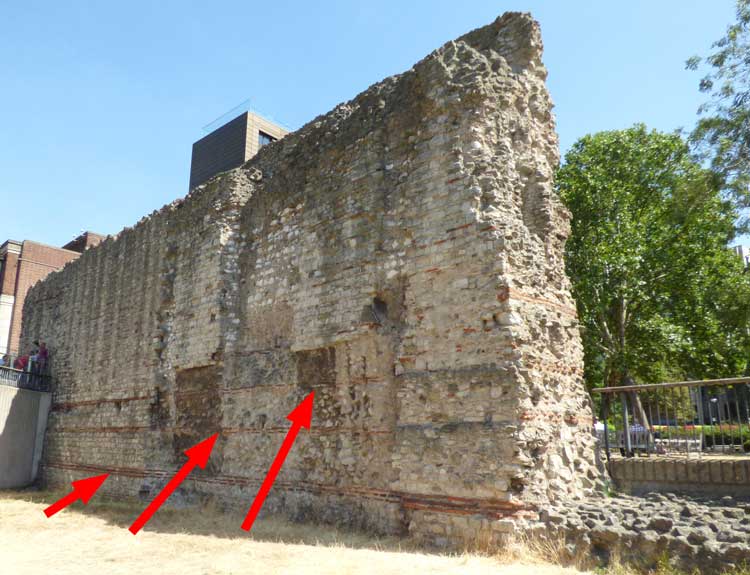
If you look at the photo you will notice several layers of red tiles spaced at intervals up the wall (I have marked them with red arrows in the photograph).
The highest one of these layers marks the surviving section of the Roman wall. All the stone above this layer is medieval.
So, if you focus on the lower section of the wall, you can see the rough Kentish ragstone that was used on each outer face of the wall.
The core of the wall would have consisted of rubble and mortar, and I do recall reading somewhere that the rubble and mortar would have been mixed with olive oil and/or fats to afford some semblance of waterproofing and to prevent frost forming in the core during the cold winter months.
This inner core would then have been sandwiched between the blocks of ragstone, and the red tiles would have been laid across the completed sections at regular intervals to provide extra strength and stability, and to prevent the ingress of water into the core on those rare occasions when it would have rained in Londinium.
The section above the third layer of red tiles dates from the heightening and repairing of the wall that took place from the medieval period onwards, and this would have continued until, in the 18th century, there being no longer a need for a defensive wall around the City of London, the majority of the wall was either demolished or else incorporated into buildings that were erected around and next to it.
Of course, one of the flaws of the human race is that we tend to only miss something after it has gone; and when the demolition of several properties in the vicinity brought this segment of the wall to light in the 1840's, people were quick to admire it, and even quicker to plan its removal.
Fortunately, as is evidenced by the following article, which appeared in The Illustrated London News on Saturday, 24th June, 1843, the wall had a sufficient number of powerful admirers to ensure it was able to repel the advances of the developers, much as it had repelled the advances of would-be assailants many centuries before:-
"Our illustration shows the only considerable portion of the old City Wall which now remains; it is behind the houses in Trinity-square, Tower-hill and bounds the western side of a plot of vacant ground in George street, on which it is proposed to build a church and schools.
The length of the extant wall is about 50 feet, and its height from 20 to 25 feet.
It is faced with masonry in regular courses, and shows, occasionally, layers of Roman bricks, especially in the lower part on the east side (recently exposed to view by the removal of some vaults and sheds), where they are seen to occur at regular intervals.
At the north angle, the wall has been strengthened and coped with brick, and is, consequently, in tolerable repair.
The proposed removal of this interesting memorial of antiquity has occasioned a correspondent of the Times to remark, that "monuments of this description should become historical evidences, nationally important; they are continually found to be of the greatest service when tracing those changes in our state and manners which time is constantly effecting; they are links in a great chain which, once lost, can never, by any means, be replaced; and they serve to connect forcibly the present and the past.
At a recent meeting of the Institute of British Architects, Mr. G. Godwin at the request of several members of the Society of Antiquaries, drew the attention of the Institute to the threatened demolition of the above portion of the London Wall; when the Marquis of Northampton, who was in the chair, suggested that the two societies should confer on the subject, and by presenting a joint memorial attempt to save this fragment of olden time from destruction."
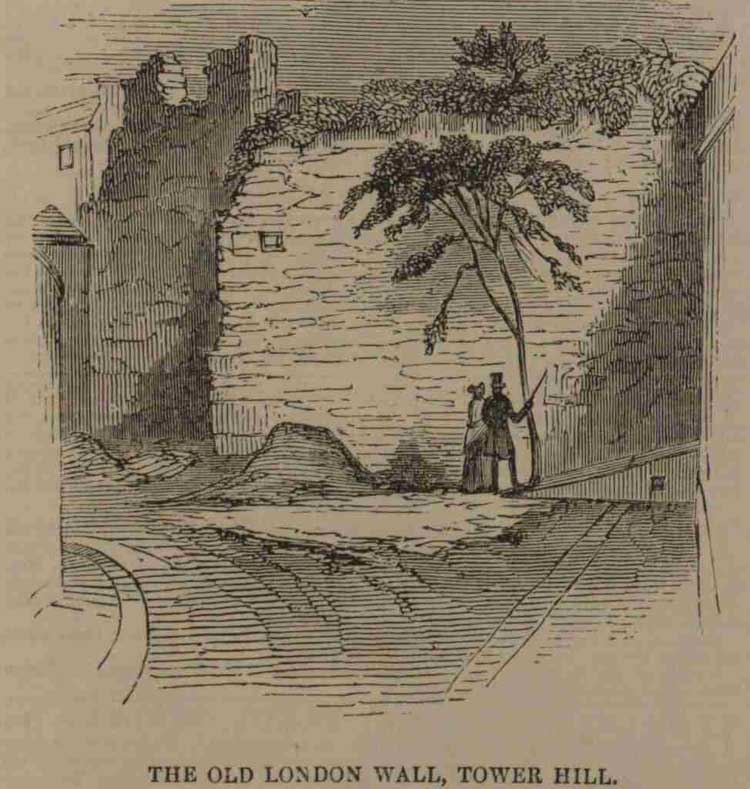
Although the wall survived the threat of 1843, it was by no means out of the woods, and on Saturday, 11th September, 1852, the Illustrated London News carried another report about new threats to the wall:-
"One of the finest fragments of the wall built by the Roman colonists of Britain around their Londinium exists to this day upon Tower-hill; it is 30-feet high, and extends over a considerable length of ground at the back of Trinity-square. It was given up by the Corporation, some few years since, to be pulled down; but the relic has been respited to the present day; and now has arisen a fresh anxiety as to its preservation.
In the almost entire absence of any other remains of the great wall which once surrounded the city, it is well worth preserving; the upper part is probably not older than the time of Henry III [1216 - 1272], but the lower is Roman work."
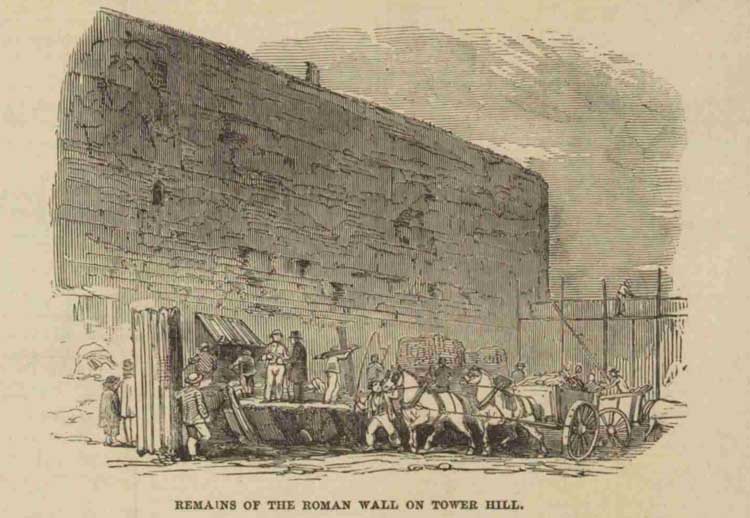
The article went on to highlight the fate that had already befallen some of the stonework that had been uncovered:-
"For two months past, excavations for foundations of buildings have been making close to this fragment, and have revealed some of the original Roman masonry, which had been concealed by houses and other buildings.
It was in excellent preservation, the facing stones quite perfect, and the rows of red tiles (such as are usually found in Roman walls) remained to the extent of two or three layers close to this portion of the wall, and piled up to a considerable height, was a mass of cut and sculptured stones, which at some remote period had formed part of one or more buildings of magnitude such as abounded in Roman London.
Some of these had been foundation-stones, others had been portions of cornices, pilasters and columns.
The most attractive of these stones has been deposited in the British Museum...The other stones have been carried off to be used, it is feared, for building materials, like many similar remains found in the city in past years.
The want of opportunities for their proper examination is to be lamented, as one of the larger flat slabs (upwards of five feet in length) is inscribed with letters, some of which are nine inches in length; they belong to a sepulchral inscription, of which only three lines (two of them incomplete) remain.
It is extremely probable that at least other portions of the inscription are upon some of the stones found with this inscribed one, but, as they are now carried away from Tower-hill, there is but little hope of their being examined."
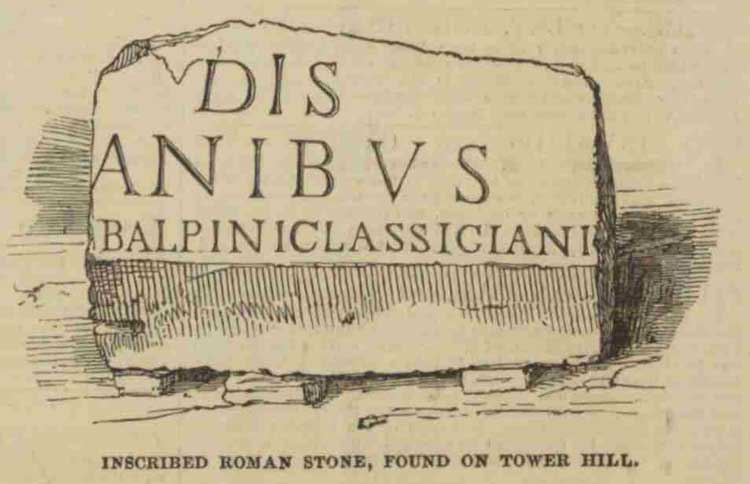
The inscribed stone mentioned in the article was, apparently, discovered quite by chance when a workman employed on the excavation work sat down to have his lunch and accidently tapped it with his foot whilst he was eating!
What the workman had stumbled upon was a portion of a substantial Roman stone tomb, which, given its size, must have been the resting place of a very important citizen of Londinium.
Indeed, as it transpired, it was, in fact, part of the tomb of Gaius Julius Alpinus Classicianus, Procurator (financial administrator) of Roman Britain from AD61 to his death in AD65, the man tasked with the rebuilding and reestablishment of Londinium in the wake of Boudica's revolt of AD61, during which the settlement had been burnt to the ground and its citizens slaughtered.
A modern replica of the stone has been embedded in the modern wall alongside the old City Wall.
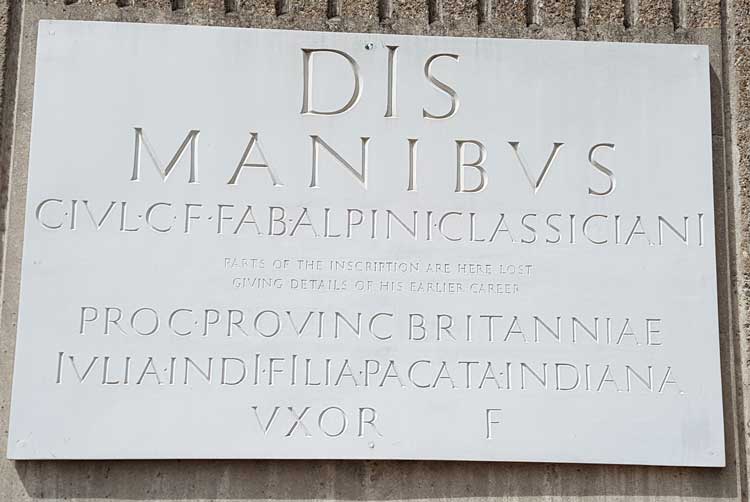
The original stone is now in the British Museum, where the entire altar tomb has been recreated and the segment slotted into it.
The inscription translates thus:-
"To the spirits of the departed (and) of Gaius Julius Alpinus Classicianus, son of Gaius, of the Fabian voting tribe, procurator of the province of Britain; Julia Pacata I[ndiana], daughter of Indus, his wife, had this built."
The photograph below shows it as it now appears in the British Museum.
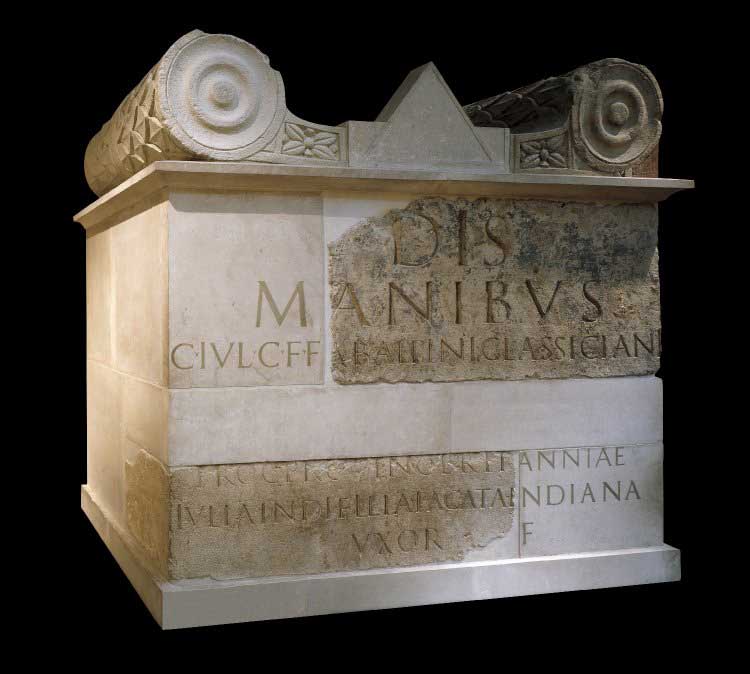
One of the most prominent features of the garden, aside from the wall itself, and the one that people do tend to notice as they hurry towards the Tower of London, is the rather splendid statue of a handsome Roman, attired in military garb that gazes out from the garden.
He is bareheaded, and wears the short tunic of a Roman general. A short sword rests beneath his left arm, whilst his right hand is raised, giving the distinct impression that he is about to launch into a pre-battle inspirational address, possibly aimed at the hordes of tourists urging them to stand firm when they see the length of the line at the Tower of London.
The statue is believed to be a depiction of the Roman Emperor Trajan (AD 98 - 117), and I'd love to be able to spin you an elaborate yarn about how it was unearthed during the aforementioned excavation work, and how another little piece of Roman London was brought to light, having lain buried in the cold London earth for close on two thousand years.
But no, the statue is of a more modern (ish) age, and was discovered in a Southampton scrapyard in the 1950's by The Reverend Philip Thomas Byard ("Tubby") Clayton (1885 - 1972), the former rector of the nearby church of All Hallows Barking.
Following his death, in 1972, in accordance with his wishes, the Tower Hill Improvement Trust placed the statue here in 1980.
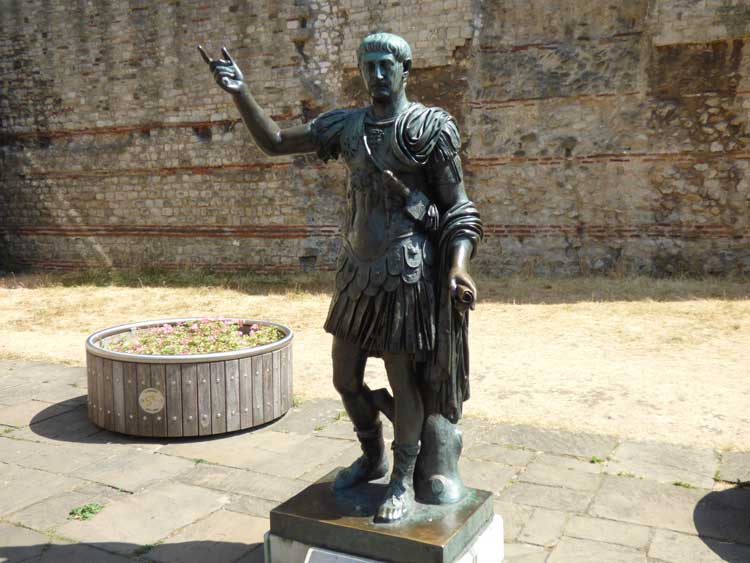
The fact that such a large fragment of the old Roman wall should have survived on Tower Hill is accounted for by two simple facts.
Firstly, as already mentioned, builders could save themselves an awful lot of time and money by simply building onto the wall, as opposed to knocking it down and starting afresh. A little bit of mortar, a layer of bricks, a dab of plaster and who's going to spot that you've recycled rather than rebuilt?
Secondly, building onto it proved a much easier task than trying to demolish it.
Those long ago Roman masons built to last; and, once up, the wall was going to prove extremely difficult to take down.
This difficulty was highlighted in the following article, which appeared in the Bognor Regis Observer on Wednesday, 12th September, 1894:-
"Tons and tons of paper have been covered with the records of discoveries and speculations (chiefly speculations) about Roman London...The existence of the Roman wall may be said to be an extremely stubborn fact, for wherever it has been met with it has required gunpowder to remove it, the Roman mortar defying pickaxes and sledge hammers.."
So, next time you find yourself on Tower Hill, just take a few minutes to pay your respects to the magnificent fragment of the Roman wall that greets you as you come out of the underground station.
It really does deserve your attention.
It was here long before any of us were here, and, no doubt, it will still be standing long after we have moved on; a brooding mass of impregnable stone that looks back proudly on ages past and long ago glories.